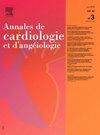Ce que le registre e-MUST dit de l’infarctus de la femme
IF 0.3
Q4 Medicine
引用次数: 0
Abstract
The issue of gender in acute myocardial infarction (AMI) emerged in the literature over 25 years ago. It became evident that, all other factors being equal, women with AMI had higher mortality rates than men. The e-MUST registry, which includes patients with ST-segment elevation myocardial infarction (STEMI) of less than 24 hours’ duration managed by one of the 39 Mobile Emergency and Resuscitation Services (SMUR) in the Île-de-France region, has allowed for numerous gender-focused analyses. Key findings include: [1] higher mortality in women: women experiencing AMI have a higher mortality risk (OR = 1.4; 95% CI: 1.1–1.8) compared to men [2]. Younger age of onset in women: while the average age at AMI onset increased by 2.9 years in men between 2002 and 2021 (from 57.6 to 60.5 years; p < 0.05), it decreased by 3.1 years in women (from 73.7 to 70.6 years; p < 0.0001) [3]. Advanced age in a subset of women: women represented 22% of the total registry population but accounted for over 60% of nonagenarian patients. In this very elderly subgroup, the rate of myocardial reperfusion decisions rose from 50% in the early 2000s to over 90% by the early 2020s. This intervention was associated with a 58% reduction in mortality [4]. Nontraditional risk profiles: women with AMI often presented without traditional cardiovascular risk factors, or with risk factors not routinely screened for [5]. Circadian patterns and delayed calls: AMI in women frequently occurred in the early morning, peaking at 08:00. Call delays to emergency services increased with age and nighttime onset, reaching up to 300 minutes in women over 65 experiencing chest pain at 1 a.m [6]. Prehospital management: except for a slightly lower rate of myocardial reperfusion in women (93% vs. 96% in men; p < 0.0001), prehospital management, including anticoagulant and antiplatelet therapy, was comparable between genders [7]. Gender bias in medical regulation: analysis of SAMU call regulation revealed that both the patient’s and the physician’s gender influenced the decision to dispatch a SMUR unit—ranging from 49% when both regulator and patient were men to just 18% when both were women [8]. Need for targeted approaches: these findings underscore the necessity for increased awareness, dedicated training, and gender-specific emergency care protocols to improve outcomes in women with AMI.
e-MUST对女性心脏病的看法
急性心肌梗死(AMI)的性别问题早在25年前就出现在文献中。很明显,在所有其他因素相同的情况下,患有急性心肌梗塞的妇女的死亡率高于男子。e-MUST登记,包括由Île-de-France地区39个流动急救和复苏服务(SMUR)之一管理的持续时间小于24小时的st段抬高型心肌梗死(STEMI)患者,允许进行许多以性别为重点的分析。主要发现包括:[1]女性死亡率更高:与男性[1]相比,患有AMI的女性死亡风险更高(OR = 1.4; 95% CI: 1.1-1.8)。女性发病年龄更年轻:2002年至2021年间,男性AMI发病平均年龄增加了2.9岁(从57.6岁增加到60.5岁;p < 0.05),女性AMI发病平均年龄减少了3.1岁(从73.7岁减少到70.6岁;p < 0.0001)。老年妇女:妇女占登记总人数的22%,但占老年患者的60%以上。在这个非常老的亚组中,心肌再灌注决定率从21世纪初的50%上升到21世纪20年代初的90%以上。这种干预与死亡率降低58%相关。非传统风险概况:AMI女性通常没有传统的心血管危险因素,或者没有常规筛查bb0的危险因素。昼夜节律模式和延迟呼叫:女性AMI经常发生在清晨,在08:00达到高峰。随着年龄的增长和夜间发病,呼叫急救服务的延误时间也在增加,65岁以上的女性在凌晨1点出现胸痛的时间长达300分钟。院前管理:除了女性心肌再灌注率略低(93% vs.男性96%;p < 0.0001)外,院前管理,包括抗凝血和抗血小板治疗,在性别之间具有可比性[0]。医疗监管中的性别偏见:对SAMU呼叫监管的分析显示,患者和医生的性别都影响了派遣SMUR单位的决定——从监管人员和患者都是男性时的49%到都是女性时的18%。需要有针对性的方法:这些发现强调了提高认识、专门培训和针对性别的紧急护理方案的必要性,以改善急性心肌梗死妇女的预后。
本文章由计算机程序翻译,如有差异,请以英文原文为准。
求助全文
约1分钟内获得全文
求助全文
来源期刊
CiteScore
0.60
自引率
0.00%
发文量
68
审稿时长
6-12 weeks
期刊介绍:
Organe scientifique de référence fondé en 1951, les Annales de cardiologie et d''angéiologie abordent tous les domaines qui intéressent quotidiennement les cardiologues et les angéiologues praticiens : neurologie et radiologie vasculaires, hémostase, diabétologie, médecine interne, épidémiologie et prévention.
Les Annales de cardiologie et d''angéiologie sont indexées aux grandes bases de données et publient rapidement, et en conformité avec les normes internationales de publication scientifique, des articles en français sur la pathologie cardiaque.

 求助内容:
求助内容: 应助结果提醒方式:
应助结果提醒方式:


